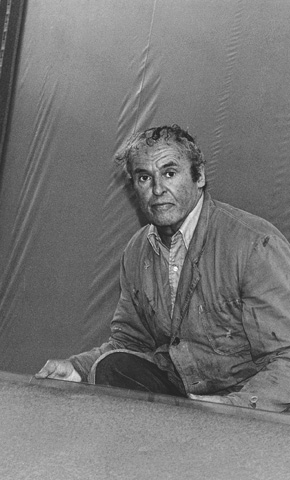|
"Red is life, energy, potency, power, love, warmth, strength. Red makes you high." In the mid-seventies Rupprecht Geiger rediscovers the work group of 14 paintings with irregular picture formats and exhibits some of them in 1977 in the Quadrat Bottrop. Starting in 1978 with the work '725/78 (Farbraum, Geist und Materie)' (WV 693), he begins to put together two geometric, archetypal forms that contrast with each other in terms of color and form. The paintings are mostly large-scale to monumental. Beginning with this group of works, he became more and more intensively involved with the color red. In 1975 Heinrich Böll gives him an empty red notebook, which the artist provides until 1978 with sketches and notes mainly on the color red. The 'Red Book 1975/78' is published as a facsimile in 1998 on the occasion of the retrospective at the Lenbachhaus in Munich. In it Rupprecht Geiger notes: "Red: the color of potency. Red is concentrated energy and manifests itself in the glowing red of the setting sun. The power of the red color: a spiritual force it is. The color with the greatest potency makes high.... Seeing, feeling, hearing red color refreshes, makes you strong - gives you power." Returning to Munich, Rupprecht Geiger first inaugurates his large studio space designed by Munich architect Detlef Schreiber. The new studio is located next to the family home in Munich-Solln and is expanded again in 1989 by the same architect. It was only after the Düsseldorf intermezzo that the Bavarian capital began to honor him, initially in 1978 with his first retrospective at the Städtische Galerie im Lenbachhaus. It takes only a few more years before he also receives numerous commissions for works in public space: in 1986 he creates four large-format Aluminum objects for the Technical University, In 1987 the Object 'Rounded Blue' in front of the Kulturzentrum am Gasteig set up, in 1989 the Subway stop Machtlfinger Straße designed according to a Geiger sketch, in 1990 the work is created 'Color Composition Red' at the Munich University of Applied Sciences. Rupprecht Geiger also received honors and awards: in 1989 he was awarded the Cultural Honorary Prize of the City of Munich, in 1992 the Culture Prize of the Bavarian State Foundation, and in 1993 the Bavarian Order of Maximilian for Science and Art. His work is not only appreciated in Bavaria. After Rupprecht Geiger participated in the 6th documenta in 1977, he also took part in many international exhibitions at home and abroad. Furthermore, numerous solo exhibitions take place in Germany, such as the highly acclaimed retrospective of 1985, which is shown in Berlin, Ludwigshafen and Düsseldorf. However, solo exhibitions of Rupprecht Geiger are not only shown throughout Germany, but all over the world:1986 at the Seiji Togo Art Museum in Tokyo, 1992 at the Hôtel des arts in Paris or 1994 at the Russian Museum in St. Petersburg, a retrospective that travels to Dresden and Munich the following year. |
 While in 1986 he was awarded the gold medal at the 8th Norwegian International Graphic Biennale in Fredrikstad for the ten color serigraph (WVG 173), he receives the Grand Art Prize of the Berlin Academy of Arts and the Grand Cross of Merit of the Federal Republic of Germany in 1988. In 1991 he is awarded the Rubens Prize of the City of Siegen and in 1994 the Harry Graf Kessler Prize of the German Artists' Association. From the mid-eighties, Rupprecht Geiger worked on new groups of works. In 1984 he designs formal abstract wooden objects, the so-called metaphor numbers 0-9. Following this theme, he conceives an extremely elaborate portfolio of large-format serigraphs on these numbers in collaboration with the Hoffmann Gallery in Friedberg, printed over several years. A little later, he begins to work on the roll images; here, the red or pink canvas attached to a roll gives the impression that it can be unrolled to infinity. In fact, one of them is more than 7 meters long, but can be transported rolled up as a small package. During this time, he also creates several walk-in room installations, such as 'Rote Trombe' in 1985, a collaborative work with Florian Geiger for the Berlin retrospective, and 'Farbraum Installation für Rot' for the Galerie Wassermann in Munich. In 1989 the Lenbachhaus acquires the room installation 'New Red for Gorbachev' and in 1990 the walk-in sculpture Meditation room for the district hospital in Taufkirchen (Vils). The color red continues to dominate. Rupprecht Geiger expresses himself about 'his' color in the form of concise formulations and comes to the following conclusion: "Red is ultimately the color of our planet. It is the color that concerns us the most, even historically, the red color occupies a special position. Red shocks." (Interview with Heinz Schütz, 1988, p. 203). After the Staatsgalerie Moderner Kunst in the Haus der Kunst dedicated a retrospective to him on his 80th birthday in 1988, the Städtische Galerie im Lenbachhaus again took on the task of congratulating the artist on his milestone birthday with an important exhibition in 1998. In the same year, he is awarded the Golden Medal of Honor of the City of Munich, the city's highest honor. Autorin: Julia Geiger |
